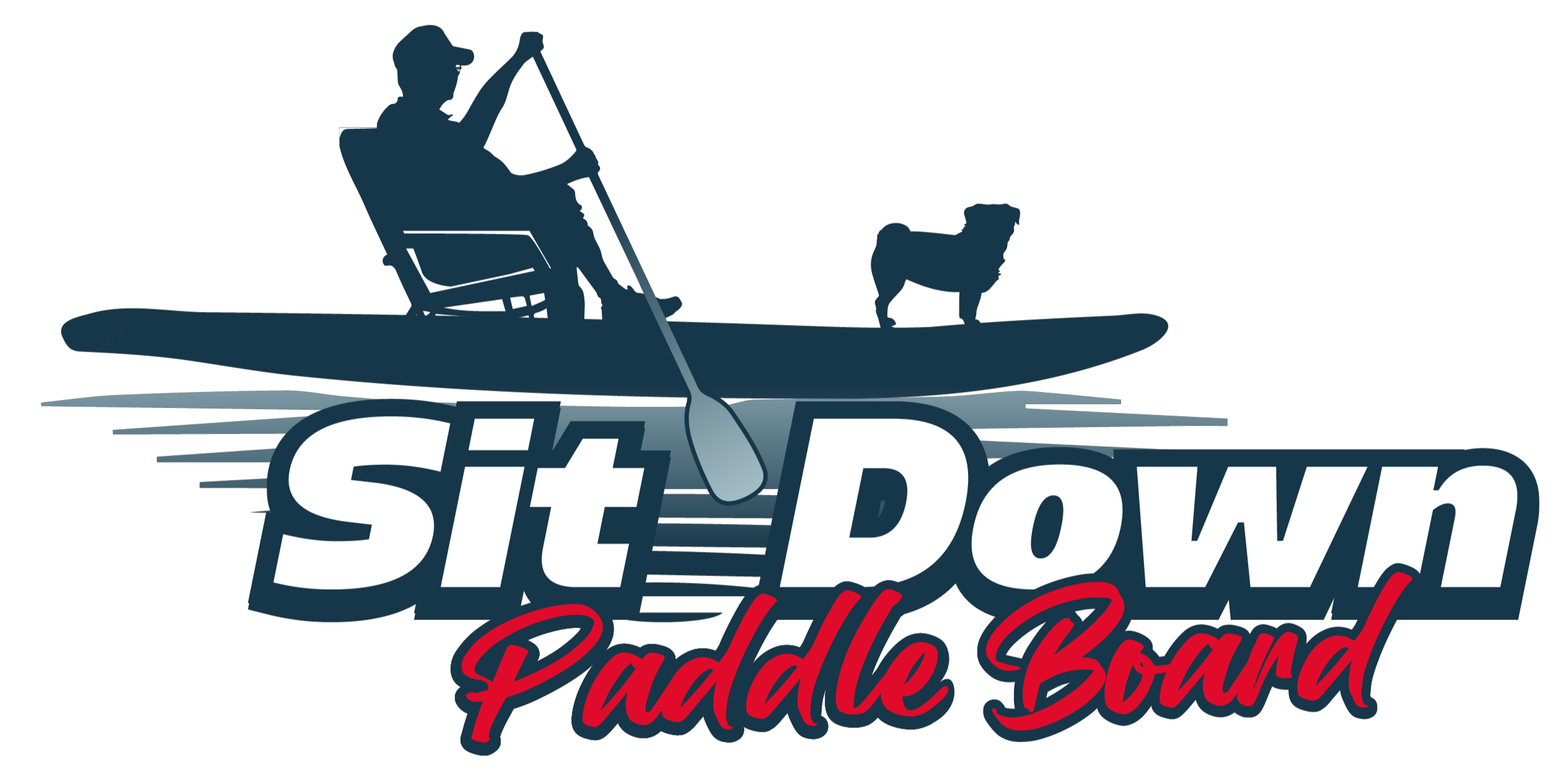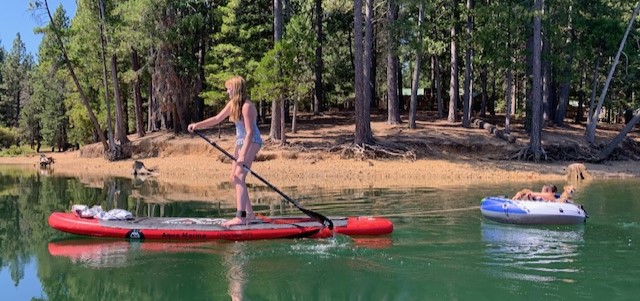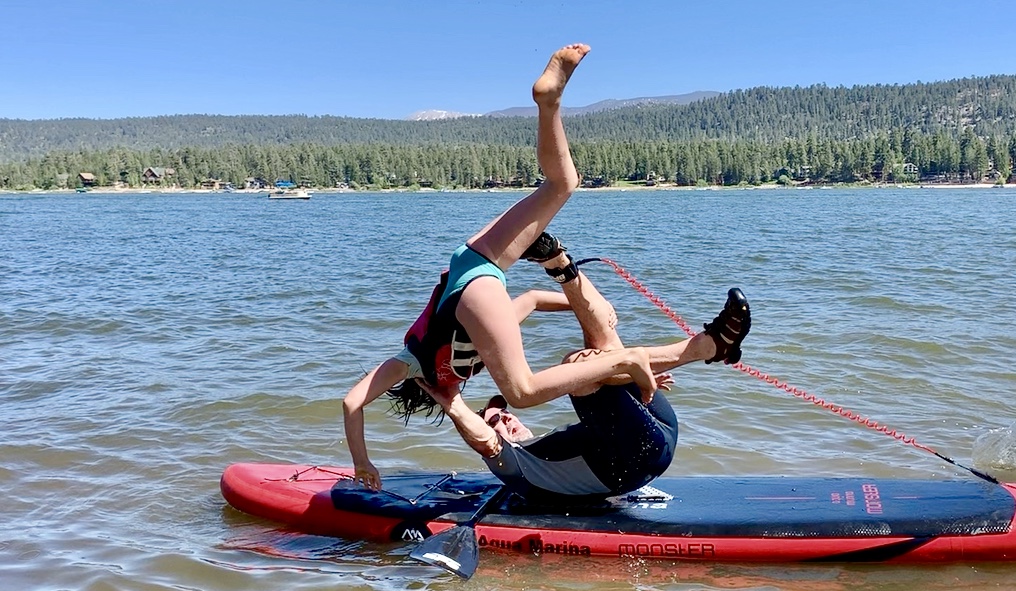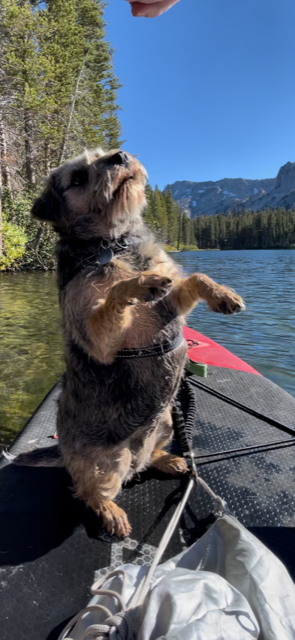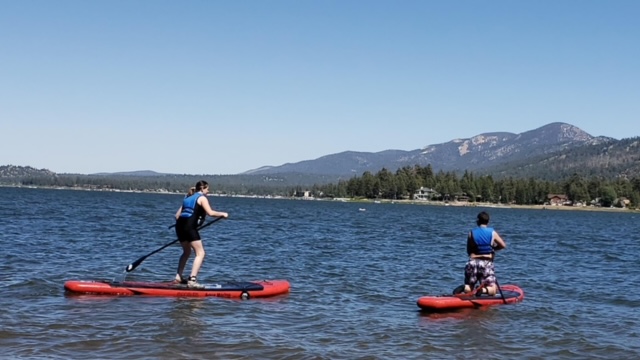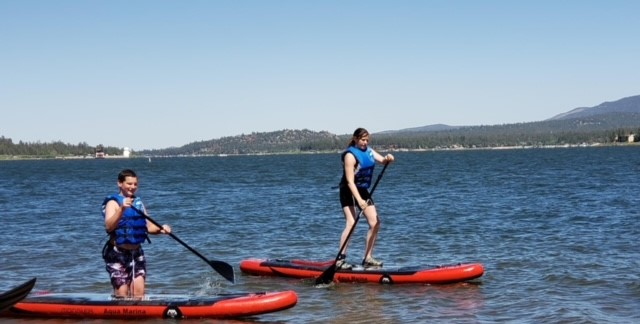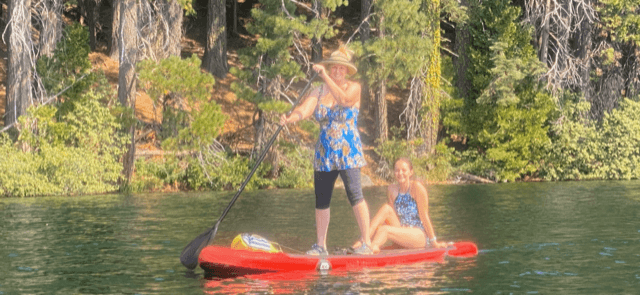How Do You Paddle Board?
Are you asking yourself, “So how do you paddle board?” Are you looking for the next adventure on the water? Stand up paddleboarding (SUP) might be just what you need. It's a fantastic full-body workout and a fun leisure activity all in one.
If you are a bit hesitant, never fear, you don’t have to stand right away! You don’t have to stand ever, if you don’t want to. Some people prefer to sit down paddle board. Read all about Sit Down Paddle Boarding.
Regardless of whether you stand up or sit down, most of the gear remains the same. When you sit down, you only need a seat and while the paddle strokes are similar, you will need to learn a kayak paddle stroke if you get a kayak paddle.
Good news is, even with little instruction, most beginners can start paddling soon after they get on a SUP board for the first time. Let's talk about the basics of SUP and get you started on your new waterborne pursuit.
The deal with paddle boarding or SUP (Stand Up Paddling) is that it's a fascinating mix of surfing and canoeing, sprinkled with a dash of balancing acts from the circus. Since you're standing tall, it's like having your own 'king of the world' moment just like Leo in Titanic, minus the dramatic backdrop!
Before you set sail–literally, there are a couple things you need to know:
- Essential Equipment 101: Just like Batman needs his Batmobile, you need a paddleboard and a handful of essentials.
- How to Paddle Board 101: Understand the basic techniques before you step on your board and steer clear of going round in circles.
- Be Wind Smart: A tip on your first outing– befriending the wind makes a huge difference.
Essential Equipment 101
So, how do you paddle board with the right gear? It's simple. You need your paddleboard, a correctly sized paddle, safety gear, a leash, and attire suited to the weather. You can rent or borrow gear initially, and then make the investment once you are hooked.
Paddle Board
Obviously, you'll need a Stand Up Paddle Board. Rent or borrow for your initial forays, but once you're hooked (which we suspect you will be!) you might want to invest in your own. Unless you are going pro, we suggest you invest in an inflatable paddle board. You can read more about all the reasons why we recommend inflatable paddle boards.
Your choice of board should depend on your weight, skill level, intended use, and local conditions. There are boards especially designed for different activities like recreational paddling, surfing, touring, racing, and SUP yoga. The hardest part about answering the question, "how do you paddle board", is that there are so many different ways to paddle board!
If you're renting, don't worry. The experts at the rental shop can help you pick out the perfect board.
For more information about which paddle board would be the right choice read:
- Ways to paddle board
- The best paddle board for beginners
- Why we like inflatable boards best
- Rigid versus Inflatables
- Sit Down Paddle Boarding
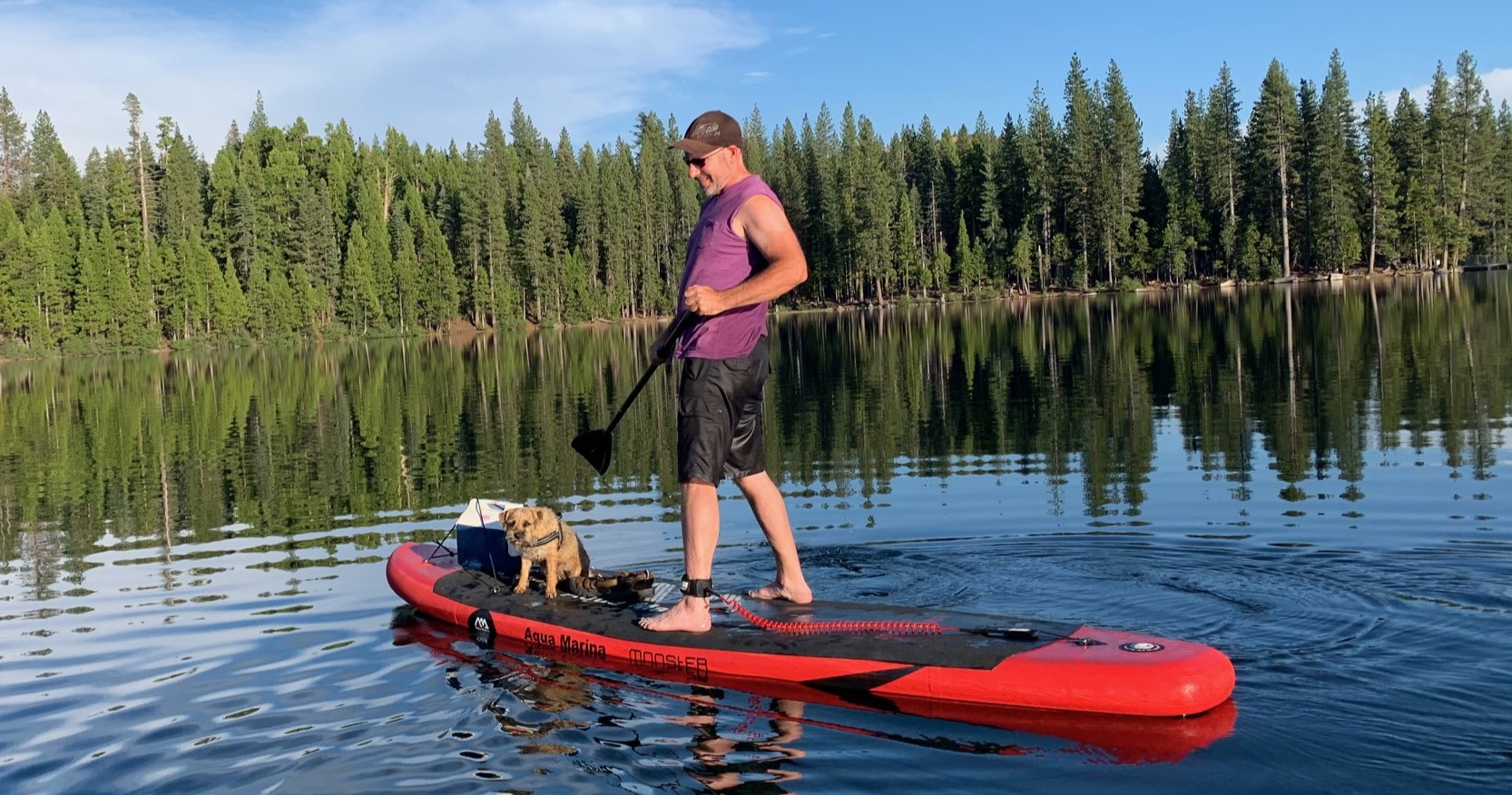 John Stand Up Paddle Boarding with our dog Wookie at Fuller Lake, CA
John Stand Up Paddle Boarding with our dog Wookie at Fuller Lake, CAPaddle
Next up is the paddle.
For stand up paddle boarding, the paddle resembles a stretched-out canoe paddle with a teardrop-shaped blade that angles forward allowing for efficient paddling. The ideal paddle length should reach your wrist when you stand it in front of you and reach your arm above your head.
If you prefer to sit down in a kayak or folding chair on your paddle board, you will likely prefer to use a kayak paddle. These can be feathered for easy stroking and range in length from 7’-8’ long.
To learn more about paddle selection and sizing, take a look at our article about the best paddle boarding paddles.
.
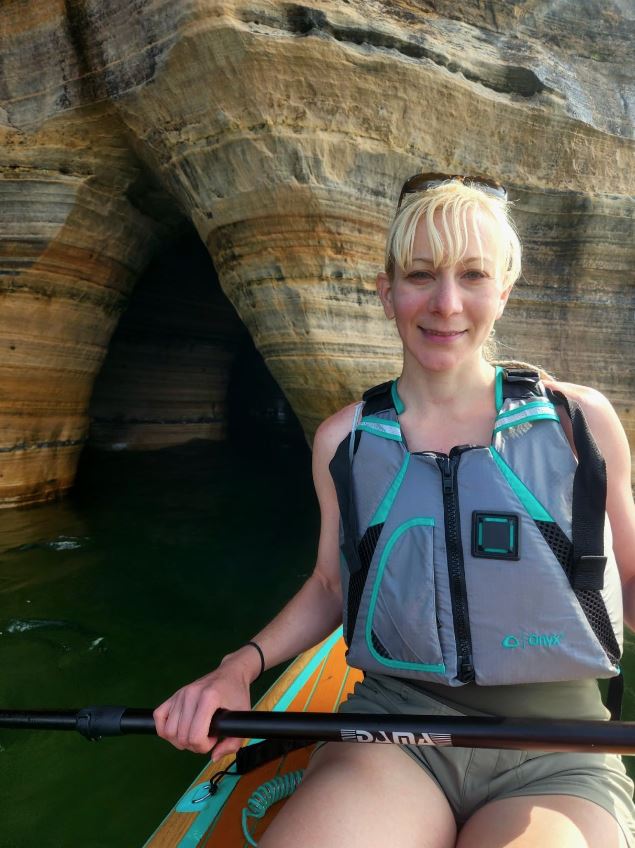
Life Jacket
Under U.S. Coast Guard regulations, Stand Up Paddle boards are classified as vessels and therefore if you're paddling outside designated surfing or swimming areas, a Personal Floatation Device (PFD) has to be on your paddle board. So when we answer the question, "how do you paddle board", the correct answer is "with a life jacket on"!
While adults can take a rain check on actually wearing the PFD, it's a must for kids. Stay informed about your state’s regulations for age requirements. Check out our article about the Best Life Jackets for Paddle Boarding.
Additional safety requirements include carrying a whistle to alert other boaters. If you're paddling past sunset, remember to keep a light on board.
Leash

Another important piece of equipment is a leash that securely ties your SUP to you.
This proves useful if you fall off. Answering the question, "how do you paddle board", needs to include "with a leash attached to us".
With your SUP serving as a sizeable floatation device, staying attached could be crucial for your safety. Leashes are designed for various conditions so make sure to buy the right one for your use.
If you are renting, the paddle board will come with a leash so you don’t have to worry about it other than to be sure you attach it to your ankle each time you get on the rental board.
Attire
When it comes to attire, in the warm summer months on a warm body of water, combine a swimsuit, board shorts, and either a short- or long-sleeved rash guard to keep the sun at bay. In cooler conditions where hypothermia could be an issue, consider wearing a wetsuit or dry suit.
We often paddle board in the spring and and fall. We have even paddle boarded on Salmon Lake, CA when there was still snow on the ground. When it is cold and we don't feel like falling or wearing a wetsuit, we sit down paddle board with neoprene tights and a fleece layer under a wind jacket. That way we stay warm, are much more comfortable than with a full wetsuit, and if we did go for an unexpected swim, we would stay warm.

Shoes
Shoes are essential for paddle boarding. While Julie likes to wear shoes when she is standing up because the wide soles provide additional stability, not everyone likes to wear shoes while they are paddling. It really is a matter of personal preference once you are on the board.
Where shoes are essential is for getting on and off of your board. The reason we answer the question, "how do you paddle board", by saying "with shoes" is because "stuff happens"!
Even if you are starting off from a beach with soft sand, you may well need to get off your board mid journey to say…. find a “restroom” (wink wink), eat some lunch on the side of the river, or because you want to take a short side hike to check out the waterfall you see from the lake, or deal with a friend’s equipment issue, etc.
Lakes and rivers often have sharp, slippery rocks which will cut your feet. If you are on the ocean, you may need to deal with rocks, reefs or tide pools and you want to have shoes on so you can fend sharp things off if need be.
When the weather or the water is cold we love paddling with neoprene paddle shoes on so our feet stay nice and warm.
As a result we suggest you wear water shoes or river sandal when you paddle board. You can always take them off and stow them under the bungee straps, but having shoes on board to protect your feet is always a good practice. Read all about the Best Shoes for Paddle Boarding.
Other Essentials
Lastly, remember to stay safe in the sun. Apply sunscreen, wear a hat, don a pair of sunglasses and wear sun-protective clothing as necessary based on where you are paddling and the conditions for the day.
For information regarding the accessories you will want to consider if you purchase a paddle board read our comprehensive article on Paddle Board Accessories.
How Do You Paddle Board 101: A Beginner's Guide to SUP Techniques
Here are our top tips for gliding gracefully on the water. Here we get really start answering the question, "How do you paddle board". Stand up paddle boarding (SUP) is a fantastic full-body workout and a fun leisure activity all in one. Here we are going to help you keep from making it more exciting than it needs to be…
Good news is, even with little instruction, most beginners can start paddling soon after they get on a SUP board for the first time. Let's talk the basics of SUP and get you started on your new waterborne pursuit.
Prefer Video? Watch our How To Paddle Board Video Series!
Getting up on your paddle board
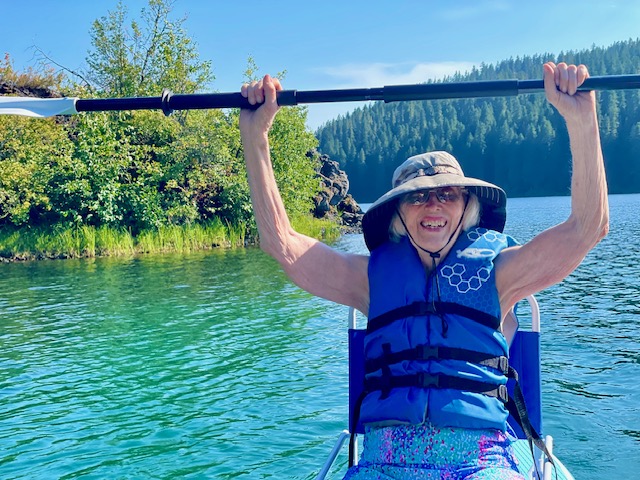
If you want to have a relaxed first experience on a paddle board, consider simply sitting on the board for the first time out. …or even every time out!
Julie’s 85-year old mother goes paddle boarding regularly, but she prefers sit down paddle boarding. She has no desire to stand up since her balance is not good and she gets cold if she is in the water for a long time. On the other hand, her balance is not good so it is much easier for her to tour all of the beautiful lakes up in the mountains by water than the billy goat paths and steep ascents necessary to see them by land. We have a page about sit down paddle boarding where you can get all of the information.
However, many people asking the question, "how do you paddle board", really are asking how to stand up paddle board. If you are up for the challenge, you've got to stand up on your SUP board. Start in knee to hip deep water, deep enough so the board’s fins don't hit the seabed and so if you fall you won’t hurt yourself.
Get onto the board on your knees just behind the center point and then carefully rise to your feet by lifting your chest first and then extending your legs. Julie has bad knees so she likes to start out on her hands and knees and then straightens her knees so that she goes into “down ward facing dog” yoga pose before bending her knees slightly, walking her hands back to her feet and standing up. Easy, right?
If you are sit down paddle boarding with a seat, the easiest thing to do is to put your seat on your board and then go out to where the water is about knee deep. Then turn around and sit down on the seat (you will be sideways) before swinging your feet onto the board and straightening your but out o the seat. Alternatively, you can swing one leg over the board and sit down. Remember, the trickiest part of sit down paddle boarding is getting on and off. However, it really is easy once you get used to it... Julie's 85 year old mother only needs someone to hold her hand and the board steady since she has bad knees and needs a little extra support.
Balance: The Key to SUP
Once you're standing up, keeping your balance is key. Position yourself so your feet are parallel, on either side of the center carrying handle and centered between the board's edges, about hip-width apart. Keep your gaze level at the horizon and ensure your weight is shifted by your hips.
The real secret to being able to balance on a paddle board easily is getting a board that is the right size. When in doubt, bigger is better in our opinion. If we had to name a size we would say start with a 12' long x 33" wide x 6" thick inflatable paddle board like the best paddle board we recommend for beginners.
If you are sitting down, balance is much easier since your center of gravity is very close to the board. Once you are on you are golden.
Paddling Like a Pro
We want to keep you from looking silly when we answer the question, "How do you paddle board". Surprisingly, a lot of new paddleboarders hold their SUP paddles incorrectly. The blade should point forward from the shaft, towards the nose of the board and the concave part of the paddle should face the back. Also, remember to switch hand positions when you change the paddle side.
Regardless of which stroke, you want to keep your arms as straight as possible and use your shoulder muscles to lift your paddle and back muscles to pull it thru the water. Your arm muscles are much smaller than your shoulder or back muscles and will tire out much sooner.
In addition, your back and shoulder muscles will activate your core, resulting in a much better work out as well as a faster, longer paddling adventure.
If you are sitting down and using a kayak paddle, you will want to hold it with both hands at shoulder's width as Julie's mother is doing in the photo above.
More on how to paddle later.
Handling the Inevitable Plunge
When answering the question, "How do you paddle board", we also have to address what to do when things go wrong. Falling off is part of the SUP experience, even the pros do it. When you do, aim to fall into the water, not onto the board and not onto your paddle. Julie bruises easily, so falling on the board is another reason that she prefers inflatable paddle boards.
After falling, first retrieve your board, get back on, and then paddle with your hands to retrieve your paddle.
If you have a life jacket on, you are much more likely to have kept ahold of your paddle when you departed your board. If so, keep ahold of it and either kick back to your board or reel your board in using the leash attached to your leg.
Wearing a life jacket provides you with a lot more options since you don’t have to swim to keep your head above water. Keeping ahold of your paddle allows you to direct it away from yourself when you fall.
If you paddle board sitting down with a chair you are much less likely to fall off. But if you do, like John did recently when we were paddling in rapids on a river in Colorado, the process to get back on your board is the same.
Perfect Your Paddling
Now comes mastering the strokes: the forward stroke, the reverse stroke, and the sweep stroke. This is the nitty gritty answer to the question, "How do you paddle board" becasue each stroke serves a different purpose - propelling you forward, slowing you down, and helping you turn respectively. Learning these strokes might be challenging at first, but with a bit of patience, you'll get there! We will talk you thru how to paddle below, but you can also watch Julie demonstrate the basic paddle strokes as well as how to stand up by clicking the video below.
Paddling while Standing with a SUP Paddle
Forward SUP Stroke – to paddle forward
This is your basic stroke for paddling thru the water. Most people asking the question, "How do you paddle board", think the answer begins and ends with how to forward stroke.
While standing with your feet at shoulder width on either side of the center strap and your knees slightly bent, reach forward from your waist using your shoulders and plant your paddle in the water as far as you can ahead of yourself without moving your body position. Push just the blade of your paddle into the water and pull the paddle back along the length of the board using your back muscles. When you get to your ankle or just behind it, the paddle should naturally come out of the water as your reach the end of your range of motion.
A few things to focus on. Keep your arms straight and twist from your torso using your back and shoulder muscles as you paddle. Push down on the paddle grip with your top hand rather than pulling the paddle back with your lower are. Visualize yourself pulling the board past the paddle rather than pulling the paddle thru the water.
To go in a straight line, you will need to alternate sides as you paddle. There is no set number of strokes per side since the wind, water current and strength on a given side will all effect how straight the board tracks thru the water.
We like to do 4-5 strokes per side before switching to the other side simply since it is more efficient. Also, don’t get too focused on keeping the board exactly straight. This is not the time to be obsessive compulsive! Relax, the board will always be slightly out of alignment from exactly where you want to go. Just keep aiming it back to where you are headed and notice how the wind, current and your paddling effects your direction and then compensate as necessary.
Reverse SUP Stroke – to paddle backward
The reverse stroke is used for slowing down, stopping and turning. It is essentially the opposite of the forward stroke.
From your basic standing position with your feet shoulder’s width on either side of the center strap and knees bent, twist your upper body and reach your paddle back behind you as far as you can towards the tail of your board with compromising your body position (other than the twisting). Push the blade into the water and push it all the way to the front of the board using your abdominal muscles, back and shoulder muscles. Again, you want to keep your arms as straight as possible and you want to twist from your torso rather than push the paddle forward with your arms.
Because the fins that keep your board tracking thru the water straight are at the back of your board, paddling backwards is more likely to cause the tip of your board to turn.
If you are performing the reverse stroke on the right side of your board, this will cause the nose of your board to turn right and vice versa for the left side. For this reason we typically only do a stroke or two on each side when we want to paddle backwards in a straight line or stop our board in a straight line.
If we are coming into dock and we want the side of the board to touch the dock instead of jamming the nose of our board into the dock, we will use a reverse stroke to bring our board sideways at the last minute and to arrest our forward momentum just before the dock.
Sweep SUP Stroke – To turn your paddle board
The sweep stroke is used for turning your paddle board. It can be used while your board is standing still or when it is moving. Using this stroke you can literally turn your paddle board around in place.
This stroke starts out just like the forward stroke where you reach forward and plant your paddle in the water. Then, instead of bringing your paddle down along the side of your board, you are going to sweep it out away from the board in a big arching motion from the nose of your board to the tail by rotation your torso and leveraging your legs and hips to pull the board around using your back, shoulder and abdominal muscles. A big sweep stroke on the right hand side of your board will turn your board to the left and vice versa.
To turn your board all the way around as if on a dime, first do a sweeping stroke on once side of your board from front to back followed by a reverse sweeping stroke from the back of the other side of the board up to the front.
A reverse sweeping stroke is the opposite of the forward sweeping stroke where you place your paddle in the water as far back as you can using your good body position and then sweep your paddle our and around to the front of your board using your hips and legs as well as your shoulder, back and stomach muscles.
Paddling while sitting down with a Kayak Paddle
Paddling with a kayak paddle is much more efficient if you are sitting down on your paddle board, especially if you are using a seat. When answering the question, "How do you paddle board", we want to be sure you know the very easiest way to get started!
Most of the strokes are similar to the strokes while paddling in that you want to involve your shoulders, back and abdominal muscles while keeping your arms straight as possible. However, a kayak paddle has a blade on both ends and you do not need to switch hands or grip when you change from one side to the other.
Here is how to paddle your paddle board using a Kayak paddle.
Forward Kayak Strokes
Same as with standing, the forward stroke is the most fundamental paddle technique. It allows you to propel your paddle board forward. Here's how to do it with a kayak paddle:
- Hold your paddle firmly; your knuckles should line up with the blade.
- Rotate your torso and immerse one of the paddle's blades fully into the water at the front of your board (near your feet if they are extended forward) while maintaining a good upright or slightly forward sitting position.
- Pull the blade through the water towards your hip using your shoulder, back and abdominal muscles, following a straight line as close to the paddle board as possible.
- As the first blade meets your hip, start submerging the other blade into the water near your feet on the opposite side and repeat the process.
Reverse Kayak Strokes
The reverse stroke is the exact opposite of the forward stroke, and it's used to move your paddle board backward.
- Hold the paddle as you would for a forward stroke.
- Instead of immersing the blade near your feet, plunge it into the water at the back of your board.
- Push the blade forward through the water, again focusing on your shoulder, abdominal and back muscles and keeping it close to the side of your paddle board.
- As the blade approaches your feet, bring it out of the water and repeat on the other side.
Sweep Kayak Strokes
Sweep strokes are used to steer the paddle board left or right without having to paddle backward.
- If you want to turn right, immerse the right kayak paddle blade into the water next to your paddle board at your feet.
- Instead of pulling it straight back, sweep it out in a wide arc away from your paddle board.
- When the paddle reaches the back of your paddle board, take it out of the water and repeat until you've turned sufficiently.
Remember, your torso plays a crucial role in the power and control of each stroke. Make sure to involve your whole body, not just your arms, while performing these strokes.
Setting Out: Be Wind Smart
Great job! You've mastered the basics. We hope we have completely answered the question, "How do you paddle board."
Want more? Watch our How To Paddle Board Video Series!
Now it's time to hit the water. For your first SUP outing, choose a calm and obstacle-free body of water. Go with a friend if possible and aim for about an hour of paddling.
Also, a pro tip: if there is wind, paddle into it on your way out, so it helps you on your way back. This is especially important if you are standing up. Paddle boarding sitting down is much easier to do into the wind since your body is not acting like a sail as much.
When we are touring a large lake we will often start off by paddling sitting down into the wind and then stand up and return to where we started standing and paddling with the wind at our back. Sometimes it will take us an hour to paddle up in the wind and only 15 minutes to paddle back since the wind makes a huge difference!
And there you have it - You're all set to begin your journey as a stand-up or sit-down paddle boarder.
We hope to see you out on the water!
